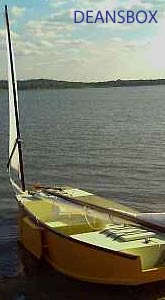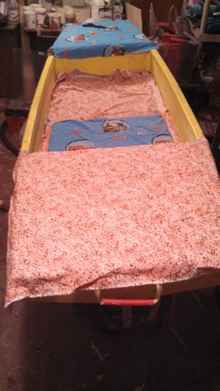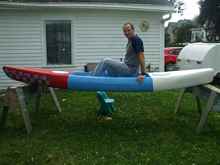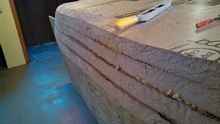
 Custom Search
|
| boat plans |
| canoe/kayak |
| electrical |
| epoxy/supplies |
| fasteners |
| gear |
| gift certificates |
| hardware |
| hatches/deckplates |
| media |
| paint/varnish |
| rope/line |
| rowing/sculling |
| sailmaking |
| sails |
| tools |
| join |
| home |
| indexes |
| classifieds |
| calendar |
| archives |
| about |
| links |
| Join Duckworks Get free newsletter CLICK HERE |
|
|
| Experiments in Foam Boats - Part Two |
by Josh Withe
- Merrimack River Valley, New England - USA |
Part One - Part Two - Part ThreeCreating SawfishMy dad loved my foam mouseboat, he decided he wanted to buy it from me, as he wants a boat that is super light and stable. I know my parents will want faster boats for paddling near their new house in Florida, this new design had to be as stable as their SOT kayaks are, but not too heavy to lift. (They each have an Ocean kayak yak board, a very stable surf kayak, but find they don't use them much as, at 40 lbs, they can't lift them). While Seafoam was a good boat, 1" foam coated with PMF, was too flexible to use as a replacement for quarter inch plywood in a much bigger hull. My mom wanted a plywood hull so she wouldn't have to worry about stomping through the hull getting in. I've read other people's attempts at foam boat building, but they really ended up with a foam cored, fiberglass boat. Not really lighter, and much more expensive than plywood/epoxy. Dave Lucas had mentioned his foam boat on duckworks, and he said he used foam stacked up like a layer cake. While he uses beaded foam board, and then has to coat it with fiberglass and epoxy to give this weak foam strength, I wanted the foam hull to be the main strength. By using 2" thick EPS (expanded polystyrene) I found foam that has about the same bend properties as ¼" plywood. gluing it into layers made it even stronger, kind of like laminating wood to make beams or plywood. Using a whole bunch of TLAR (that looks about right), I settled on a 12 foot long hull, 28" wide, since I know that is a safe width for people who are not so stable, while not being too wide to paddle comfortably. Using one sheet of 4x8 foot, 2 inch thick foam, and one 2x8 foot, 2 inch foam, I found I could draw out the parts for a complete hull. (google "sawfish kayak" for complete plans and instructions). I glued most of the hull together with Gorilla glue (GG) and used Great Stuff (GS) in a few spots to fill large gaps. I used a flat concrete floor as my building form, with a brick holding up each end to force some rocker into the hull. With all the layers glued together, I had a hull that looked kind of like my daughter had made it in her Minecraft game. Using a Sureform I carved away the blocky edges until a rounded boat hull appeared. I kind of imagined I was like the first log canoe builders, starting with a non boat shaped object, and freeing the boat locked inside. I made Sawfish with forward and aft sealed storage compartments, each has a gama seal hatch to keep it watertight. The top decks on the ends are only 1" thick foam, to make them stronger I added "beams" of foam under the deck. (the next boat will have wood beams). Sealed compartments in a foam boat are not needed for flotation, but instead to keep your drinks and lunch cool, and your wallet, car keys, phone, camera, towel, etc. dry.
Since foam is a weak material when pulled on, I ended up attaching handles to the hull using a hole through the hull to make it strong. After boring a ½" hole through hull, I pumped the hole full of PLpremium. Using a coat hanger I pushed the end of a nylon strap all the way into the hull. then threaded a section of plastic pipe onto the strap for a handle. I used the coat hanger to push the other end of the nylon strap into the opposite side of the hull, as deep as it could. The handle is on a loop running through the hull. Unless I rip the end off the kayak, the handles will not come off, as the foam they run through is held in place by the PMF skin. We had an exceptionally long snowy winter up here (yay! great cross country skiing!), so while I waited for the snow to melt, I cut out enough ribs, noses, and bottoms for another three Sawfish. I got a second hull almost to the sanding-to-shape stage before the weather broke and the snow was gone. Launch With a boat shaped hull that weighed 13 lbs, I set off one cool, blustery spring day for the local pond. The boat was just raw, pink foam, boat shaped, but not anything seen before around here. As I unstrapped the kayak, more than one fisherman came over to ask what I was launching. One of them got out his phone and videoed the whole launch, I'm sure he thought it would be funny to see me swimming. Afterwards, I saw him showing the video to others around the pond. I found that my 180 lbs didn't even push the bottom layer of foam below the water. When I test leaned the hull, water ran in through the GG seams. That is ok though, they don't have to be watertight, just strong. I took Sawfish for a short paddle, testing how fast the boat was, how stable, and how she turned. I was impressed that my first boat design worked so well, everyone else was impressed that it didn't fall apart and leave me swimming. I coated the hull with PMF, then painted with an unusual paint job since Sawfish would be a float in an Independence Day parade before I ever got to paddle the finished hull. I ended up adding a skeg, made from a plastic cutting board, to cure a slight tendency to wander while paddling. Back when I started writing this, I mentioned that I wanted to build a foam camper for six. Once Sawfish was complete and launched, I stopped building boats, and went full time into building a foam camper. We already had a reservation at a campground in the Adirondacks, I had to build enough of a camper for us to be able to stay in it. We missed the first two days of our reservation due to last minute details, but rolled onto the campground with our foam camper loaded to the gills with boats and camping gear. Sawfish, and my whole fleet, had a busy week. While my sister and her family camped with our kids on one pond, my wife and I slept in the foam camper 4 miles away. We traveled back and forth by water. Paddling back each night by the light of the moon. Sawfish proved to be much faster than any of the mouseboats, and able to haul a good load of gear in and out of the campsite. One feature of that area of the Adirondacks is an abundance of ponds, lakes and rivers, many so close together you can carry from one to the next, along marked canoe carry paths. Sawfish was perfect for this, thanks to her finished weight of 22 lbs, carrying between ponds was no big deal. While other paddlers were taking one trip with the boat(s) and a second for their gear, I could hike Sawfish on one shoulder, and the seat on my other shoulder, then walk off with my paddle in one hand. I even tried Dave Lucas's idea of wearing Sawfish like a hat, thanks to the soft foam hull, it was very comfortable, but it limited my view of the Adirondack woods. |
To comment on Duckworks articles, please visit one of the following:
|
 |







